Evidence-Based Mental Health Nursing: Tidal Model and Care Planning
VerifiedAdded on 2023/05/30
|26
|7991
|416
Essay
AI Summary
This essay provides an in-depth analysis of evidence-based mental health nursing practices, utilizing the Tidal Model and Care Programme Approach (CPA) framework. It focuses on the assessment and care planning for a 49-year-old woman named Harper, who has a history of cerebral palsy, learning disabilities, and emotionally unstable personality disorder. The essay details Harper's challenging background, including childhood abuse and subsequent behavioral issues. It highlights the importance of thorough assessment using tools aligned with the Tidal Model, emphasizing patient empowerment and understanding their unique story. The care plan developed addresses Harper's specific needs, aiming to reduce violence, promote emotional stability, and improve her overall quality of life. The essay concludes by underscoring the effectiveness of integrating evidence-based practices and patient-centered approaches in mental health nursing.
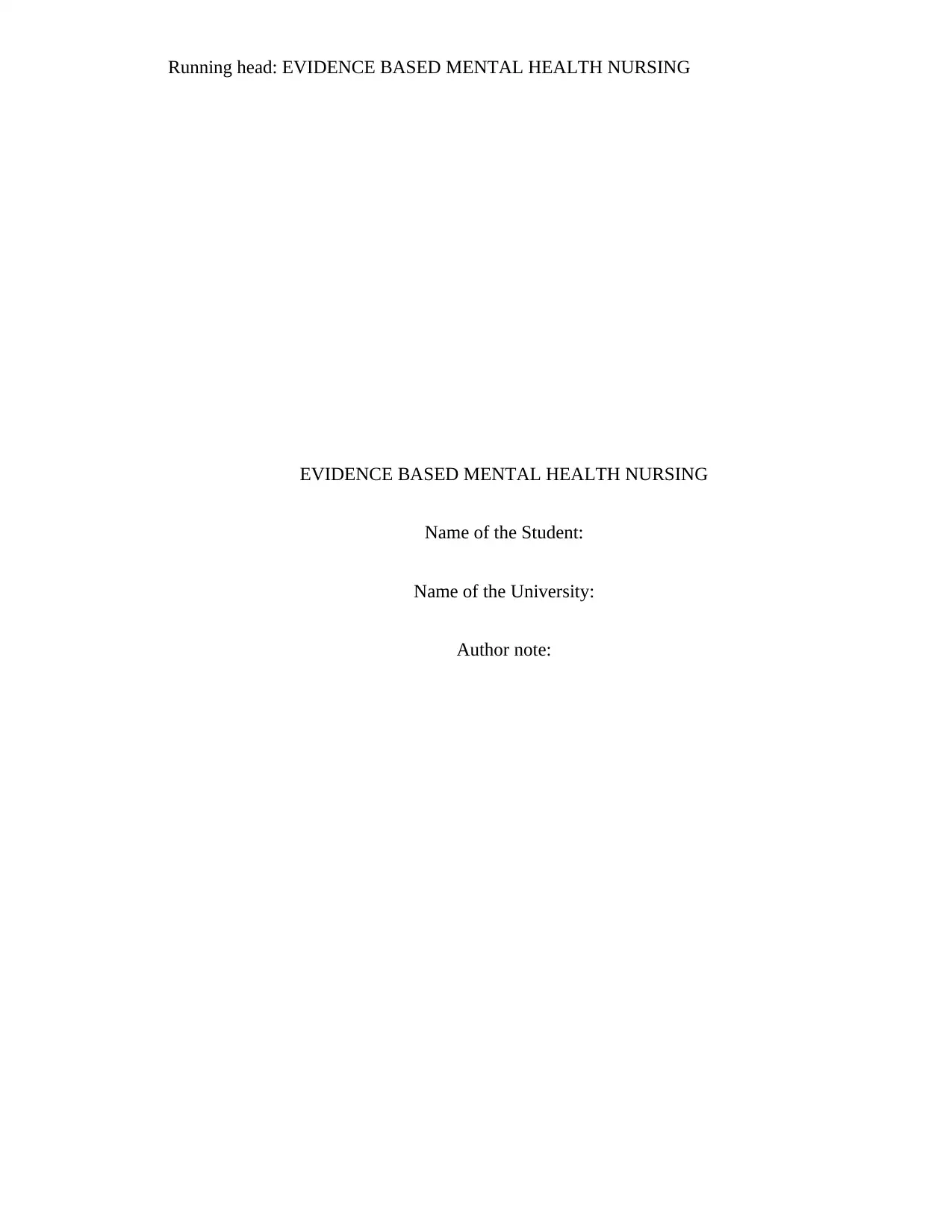
Running head: EVIDENCE BASED MENTAL HEALTH NURSING
EVIDENCE BASED MENTAL HEALTH NURSING
Name of the Student:
Name of the University:
Author note:
EVIDENCE BASED MENTAL HEALTH NURSING
Name of the Student:
Name of the University:
Author note:
Paraphrase This Document
Need a fresh take? Get an instant paraphrase of this document with our AI Paraphraser
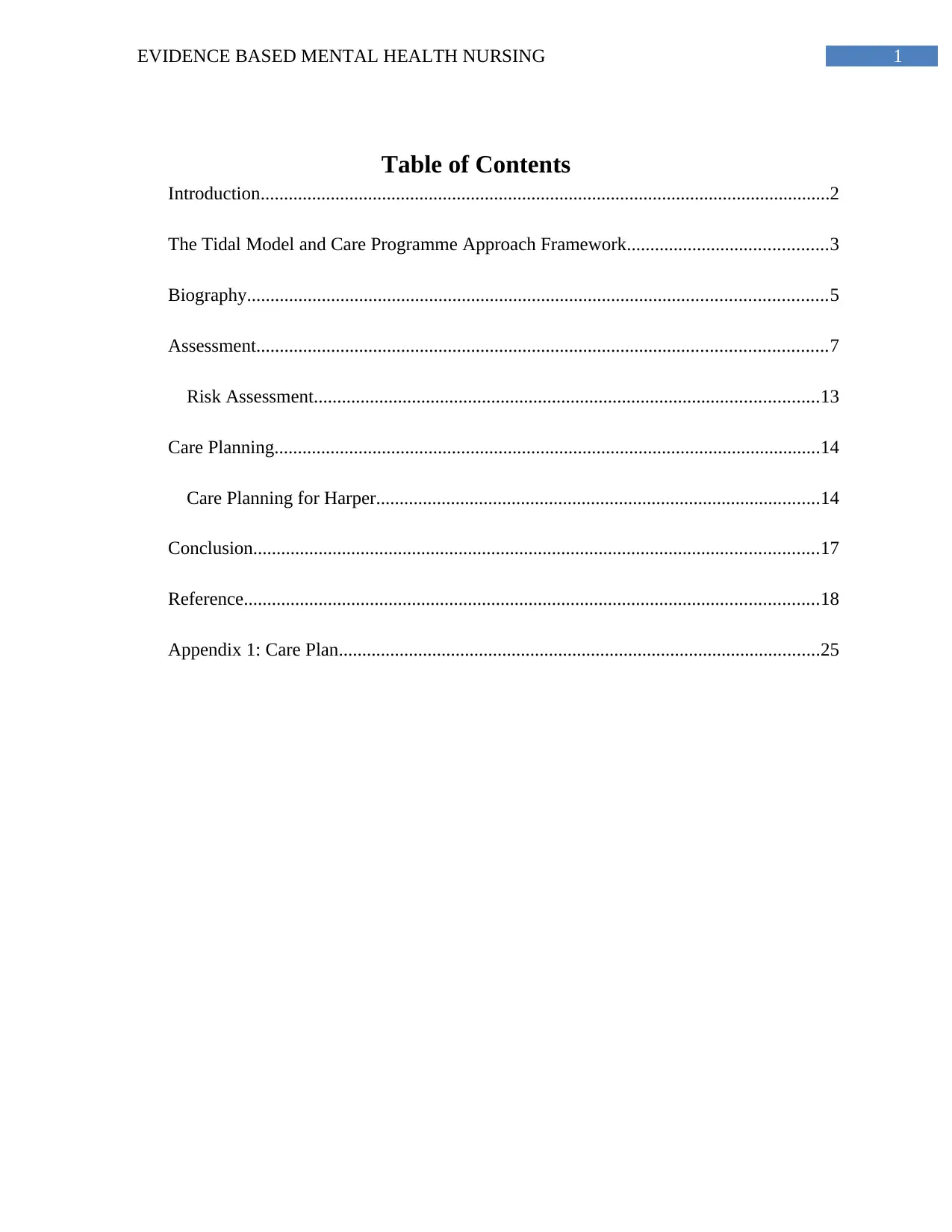
1EVIDENCE BASED MENTAL HEALTH NURSING
Table of Contents
Introduction..........................................................................................................................2
The Tidal Model and Care Programme Approach Framework...........................................3
Biography............................................................................................................................5
Assessment..........................................................................................................................7
Risk Assessment............................................................................................................13
Care Planning.....................................................................................................................14
Care Planning for Harper...............................................................................................14
Conclusion.........................................................................................................................17
Reference...........................................................................................................................18
Appendix 1: Care Plan.......................................................................................................25
Table of Contents
Introduction..........................................................................................................................2
The Tidal Model and Care Programme Approach Framework...........................................3
Biography............................................................................................................................5
Assessment..........................................................................................................................7
Risk Assessment............................................................................................................13
Care Planning.....................................................................................................................14
Care Planning for Harper...............................................................................................14
Conclusion.........................................................................................................................17
Reference...........................................................................................................................18
Appendix 1: Care Plan.......................................................................................................25
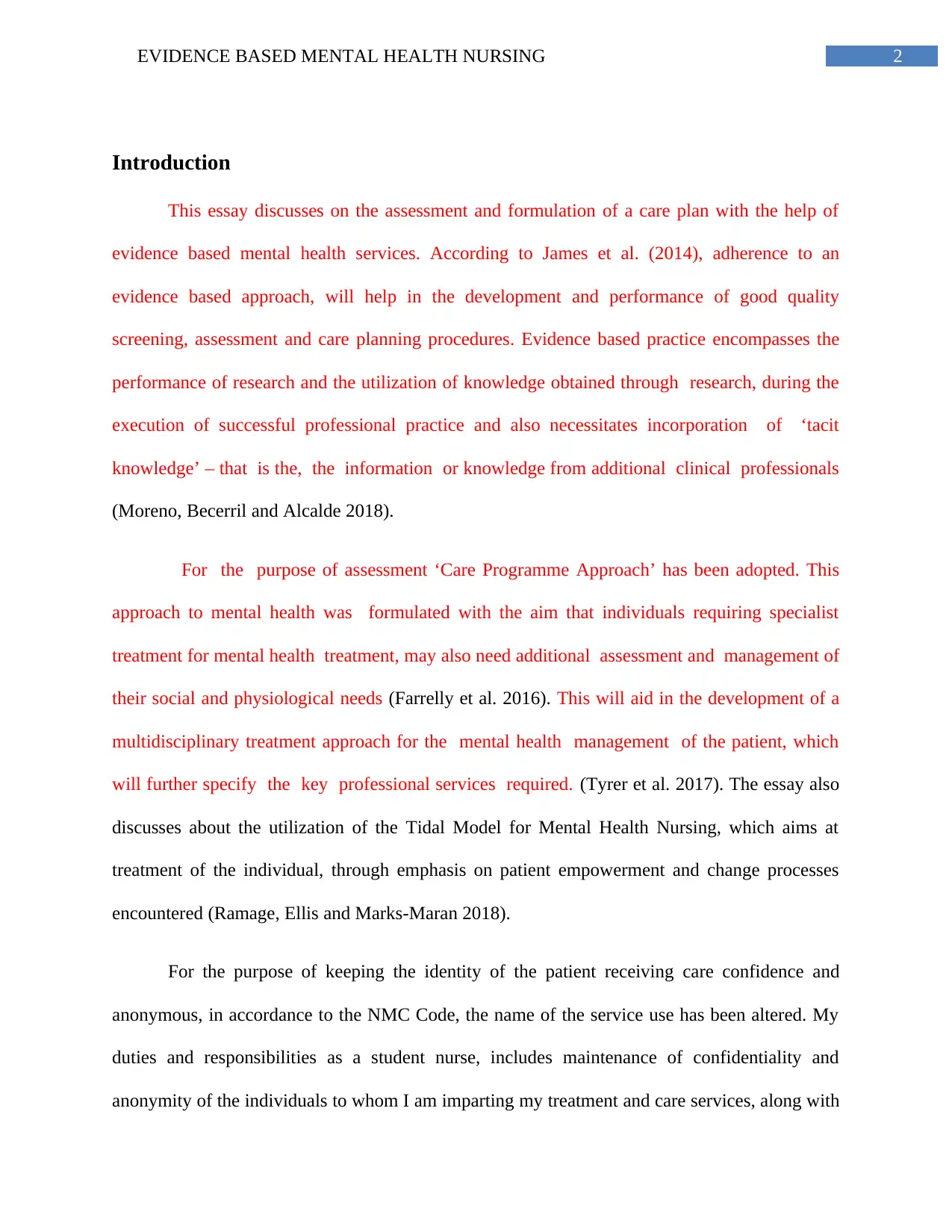
2EVIDENCE BASED MENTAL HEALTH NURSING
Introduction
This essay discusses on the assessment and formulation of a care plan with the help of
evidence based mental health services. According to James et al. (2014), adherence to an
evidence based approach, will help in the development and performance of good quality
screening, assessment and care planning procedures. Evidence based practice encompasses the
performance of research and the utilization of knowledge obtained through research, during the
execution of successful professional practice and also necessitates incorporation of ‘tacit
knowledge’ – that is the, the information or knowledge from additional clinical professionals
(Moreno, Becerril and Alcalde 2018).
For the purpose of assessment ‘Care Programme Approach’ has been adopted. This
approach to mental health was formulated with the aim that individuals requiring specialist
treatment for mental health treatment, may also need additional assessment and management of
their social and physiological needs (Farrelly et al. 2016). This will aid in the development of a
multidisciplinary treatment approach for the mental health management of the patient, which
will further specify the key professional services required. (Tyrer et al. 2017). The essay also
discusses about the utilization of the Tidal Model for Mental Health Nursing, which aims at
treatment of the individual, through emphasis on patient empowerment and change processes
encountered (Ramage, Ellis and Marks-Maran 2018).
For the purpose of keeping the identity of the patient receiving care confidence and
anonymous, in accordance to the NMC Code, the name of the service use has been altered. My
duties and responsibilities as a student nurse, includes maintenance of confidentiality and
anonymity of the individuals to whom I am imparting my treatment and care services, along with
Introduction
This essay discusses on the assessment and formulation of a care plan with the help of
evidence based mental health services. According to James et al. (2014), adherence to an
evidence based approach, will help in the development and performance of good quality
screening, assessment and care planning procedures. Evidence based practice encompasses the
performance of research and the utilization of knowledge obtained through research, during the
execution of successful professional practice and also necessitates incorporation of ‘tacit
knowledge’ – that is the, the information or knowledge from additional clinical professionals
(Moreno, Becerril and Alcalde 2018).
For the purpose of assessment ‘Care Programme Approach’ has been adopted. This
approach to mental health was formulated with the aim that individuals requiring specialist
treatment for mental health treatment, may also need additional assessment and management of
their social and physiological needs (Farrelly et al. 2016). This will aid in the development of a
multidisciplinary treatment approach for the mental health management of the patient, which
will further specify the key professional services required. (Tyrer et al. 2017). The essay also
discusses about the utilization of the Tidal Model for Mental Health Nursing, which aims at
treatment of the individual, through emphasis on patient empowerment and change processes
encountered (Ramage, Ellis and Marks-Maran 2018).
For the purpose of keeping the identity of the patient receiving care confidence and
anonymous, in accordance to the NMC Code, the name of the service use has been altered. My
duties and responsibilities as a student nurse, includes maintenance of confidentiality and
anonymity of the individuals to whom I am imparting my treatment and care services, along with
⊘ This is a preview!⊘
Do you want full access?
Subscribe today to unlock all pages.

Trusted by 1+ million students worldwide
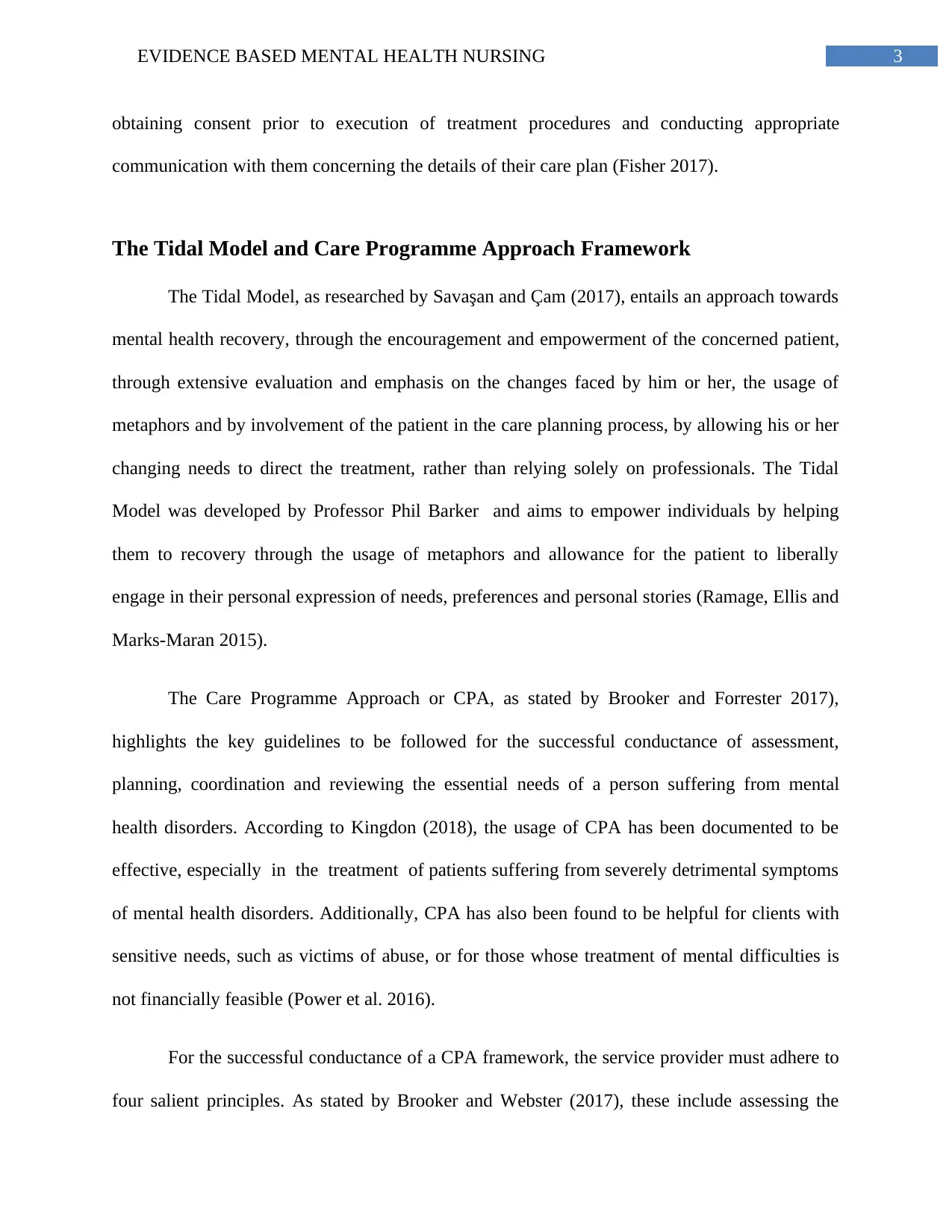
3EVIDENCE BASED MENTAL HEALTH NURSING
obtaining consent prior to execution of treatment procedures and conducting appropriate
communication with them concerning the details of their care plan (Fisher 2017).
The Tidal Model and Care Programme Approach Framework
The Tidal Model, as researched by Savaşan and Çam (2017), entails an approach towards
mental health recovery, through the encouragement and empowerment of the concerned patient,
through extensive evaluation and emphasis on the changes faced by him or her, the usage of
metaphors and by involvement of the patient in the care planning process, by allowing his or her
changing needs to direct the treatment, rather than relying solely on professionals. The Tidal
Model was developed by Professor Phil Barker and aims to empower individuals by helping
them to recovery through the usage of metaphors and allowance for the patient to liberally
engage in their personal expression of needs, preferences and personal stories (Ramage, Ellis and
Marks-Maran 2015).
The Care Programme Approach or CPA, as stated by Brooker and Forrester 2017),
highlights the key guidelines to be followed for the successful conductance of assessment,
planning, coordination and reviewing the essential needs of a person suffering from mental
health disorders. According to Kingdon (2018), the usage of CPA has been documented to be
effective, especially in the treatment of patients suffering from severely detrimental symptoms
of mental health disorders. Additionally, CPA has also been found to be helpful for clients with
sensitive needs, such as victims of abuse, or for those whose treatment of mental difficulties is
not financially feasible (Power et al. 2016).
For the successful conductance of a CPA framework, the service provider must adhere to
four salient principles. As stated by Brooker and Webster (2017), these include assessing the
obtaining consent prior to execution of treatment procedures and conducting appropriate
communication with them concerning the details of their care plan (Fisher 2017).
The Tidal Model and Care Programme Approach Framework
The Tidal Model, as researched by Savaşan and Çam (2017), entails an approach towards
mental health recovery, through the encouragement and empowerment of the concerned patient,
through extensive evaluation and emphasis on the changes faced by him or her, the usage of
metaphors and by involvement of the patient in the care planning process, by allowing his or her
changing needs to direct the treatment, rather than relying solely on professionals. The Tidal
Model was developed by Professor Phil Barker and aims to empower individuals by helping
them to recovery through the usage of metaphors and allowance for the patient to liberally
engage in their personal expression of needs, preferences and personal stories (Ramage, Ellis and
Marks-Maran 2015).
The Care Programme Approach or CPA, as stated by Brooker and Forrester 2017),
highlights the key guidelines to be followed for the successful conductance of assessment,
planning, coordination and reviewing the essential needs of a person suffering from mental
health disorders. According to Kingdon (2018), the usage of CPA has been documented to be
effective, especially in the treatment of patients suffering from severely detrimental symptoms
of mental health disorders. Additionally, CPA has also been found to be helpful for clients with
sensitive needs, such as victims of abuse, or for those whose treatment of mental difficulties is
not financially feasible (Power et al. 2016).
For the successful conductance of a CPA framework, the service provider must adhere to
four salient principles. As stated by Brooker and Webster (2017), these include assessing the
Paraphrase This Document
Need a fresh take? Get an instant paraphrase of this document with our AI Paraphraser
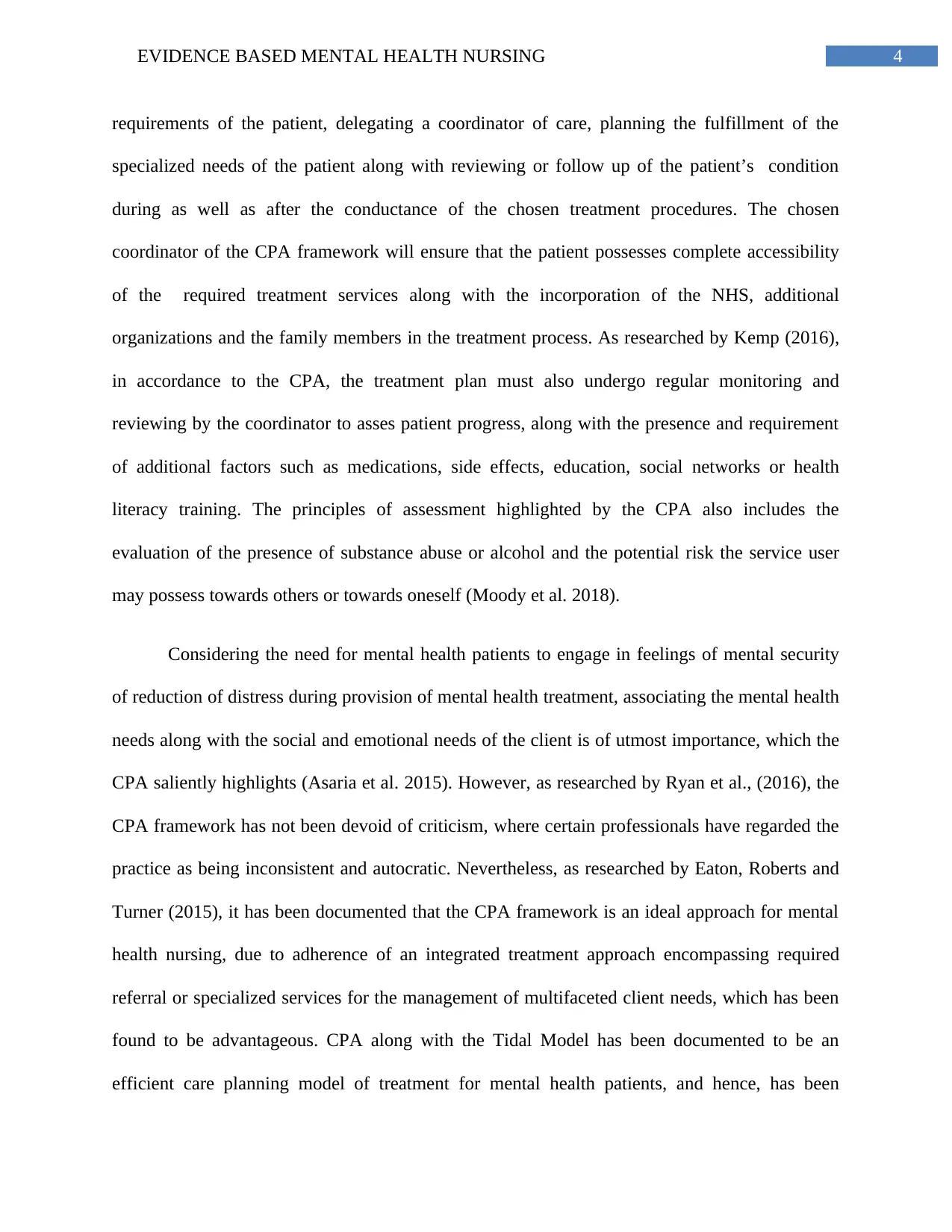
4EVIDENCE BASED MENTAL HEALTH NURSING
requirements of the patient, delegating a coordinator of care, planning the fulfillment of the
specialized needs of the patient along with reviewing or follow up of the patient’s condition
during as well as after the conductance of the chosen treatment procedures. The chosen
coordinator of the CPA framework will ensure that the patient possesses complete accessibility
of the required treatment services along with the incorporation of the NHS, additional
organizations and the family members in the treatment process. As researched by Kemp (2016),
in accordance to the CPA, the treatment plan must also undergo regular monitoring and
reviewing by the coordinator to asses patient progress, along with the presence and requirement
of additional factors such as medications, side effects, education, social networks or health
literacy training. The principles of assessment highlighted by the CPA also includes the
evaluation of the presence of substance abuse or alcohol and the potential risk the service user
may possess towards others or towards oneself (Moody et al. 2018).
Considering the need for mental health patients to engage in feelings of mental security
of reduction of distress during provision of mental health treatment, associating the mental health
needs along with the social and emotional needs of the client is of utmost importance, which the
CPA saliently highlights (Asaria et al. 2015). However, as researched by Ryan et al., (2016), the
CPA framework has not been devoid of criticism, where certain professionals have regarded the
practice as being inconsistent and autocratic. Nevertheless, as researched by Eaton, Roberts and
Turner (2015), it has been documented that the CPA framework is an ideal approach for mental
health nursing, due to adherence of an integrated treatment approach encompassing required
referral or specialized services for the management of multifaceted client needs, which has been
found to be advantageous. CPA along with the Tidal Model has been documented to be an
efficient care planning model of treatment for mental health patients, and hence, has been
requirements of the patient, delegating a coordinator of care, planning the fulfillment of the
specialized needs of the patient along with reviewing or follow up of the patient’s condition
during as well as after the conductance of the chosen treatment procedures. The chosen
coordinator of the CPA framework will ensure that the patient possesses complete accessibility
of the required treatment services along with the incorporation of the NHS, additional
organizations and the family members in the treatment process. As researched by Kemp (2016),
in accordance to the CPA, the treatment plan must also undergo regular monitoring and
reviewing by the coordinator to asses patient progress, along with the presence and requirement
of additional factors such as medications, side effects, education, social networks or health
literacy training. The principles of assessment highlighted by the CPA also includes the
evaluation of the presence of substance abuse or alcohol and the potential risk the service user
may possess towards others or towards oneself (Moody et al. 2018).
Considering the need for mental health patients to engage in feelings of mental security
of reduction of distress during provision of mental health treatment, associating the mental health
needs along with the social and emotional needs of the client is of utmost importance, which the
CPA saliently highlights (Asaria et al. 2015). However, as researched by Ryan et al., (2016), the
CPA framework has not been devoid of criticism, where certain professionals have regarded the
practice as being inconsistent and autocratic. Nevertheless, as researched by Eaton, Roberts and
Turner (2015), it has been documented that the CPA framework is an ideal approach for mental
health nursing, due to adherence of an integrated treatment approach encompassing required
referral or specialized services for the management of multifaceted client needs, which has been
found to be advantageous. CPA along with the Tidal Model has been documented to be an
efficient care planning model of treatment for mental health patients, and hence, has been
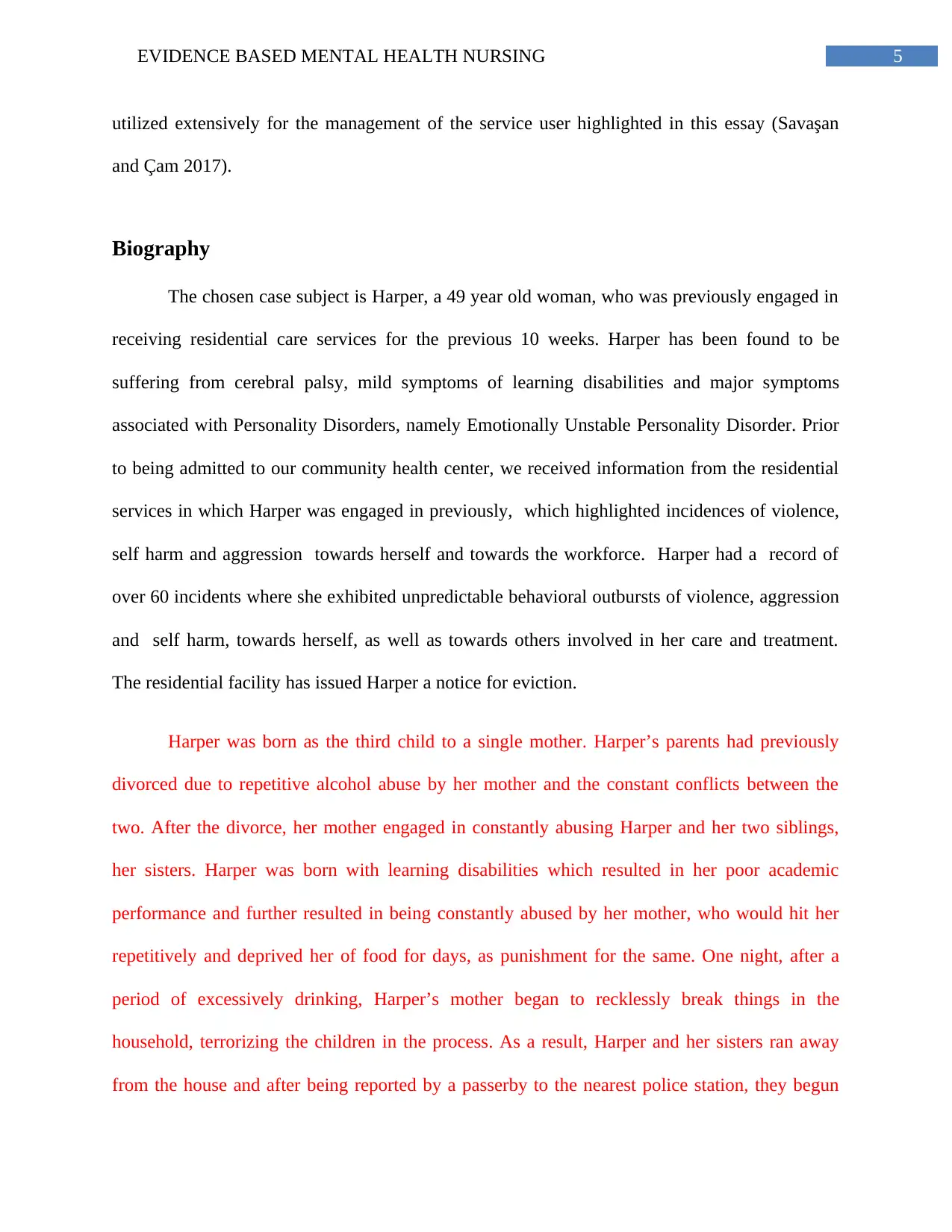
5EVIDENCE BASED MENTAL HEALTH NURSING
utilized extensively for the management of the service user highlighted in this essay (Savaşan
and Çam 2017).
Biography
The chosen case subject is Harper, a 49 year old woman, who was previously engaged in
receiving residential care services for the previous 10 weeks. Harper has been found to be
suffering from cerebral palsy, mild symptoms of learning disabilities and major symptoms
associated with Personality Disorders, namely Emotionally Unstable Personality Disorder. Prior
to being admitted to our community health center, we received information from the residential
services in which Harper was engaged in previously, which highlighted incidences of violence,
self harm and aggression towards herself and towards the workforce. Harper had a record of
over 60 incidents where she exhibited unpredictable behavioral outbursts of violence, aggression
and self harm, towards herself, as well as towards others involved in her care and treatment.
The residential facility has issued Harper a notice for eviction.
Harper was born as the third child to a single mother. Harper’s parents had previously
divorced due to repetitive alcohol abuse by her mother and the constant conflicts between the
two. After the divorce, her mother engaged in constantly abusing Harper and her two siblings,
her sisters. Harper was born with learning disabilities which resulted in her poor academic
performance and further resulted in being constantly abused by her mother, who would hit her
repetitively and deprived her of food for days, as punishment for the same. One night, after a
period of excessively drinking, Harper’s mother began to recklessly break things in the
household, terrorizing the children in the process. As a result, Harper and her sisters ran away
from the house and after being reported by a passerby to the nearest police station, they begun
utilized extensively for the management of the service user highlighted in this essay (Savaşan
and Çam 2017).
Biography
The chosen case subject is Harper, a 49 year old woman, who was previously engaged in
receiving residential care services for the previous 10 weeks. Harper has been found to be
suffering from cerebral palsy, mild symptoms of learning disabilities and major symptoms
associated with Personality Disorders, namely Emotionally Unstable Personality Disorder. Prior
to being admitted to our community health center, we received information from the residential
services in which Harper was engaged in previously, which highlighted incidences of violence,
self harm and aggression towards herself and towards the workforce. Harper had a record of
over 60 incidents where she exhibited unpredictable behavioral outbursts of violence, aggression
and self harm, towards herself, as well as towards others involved in her care and treatment.
The residential facility has issued Harper a notice for eviction.
Harper was born as the third child to a single mother. Harper’s parents had previously
divorced due to repetitive alcohol abuse by her mother and the constant conflicts between the
two. After the divorce, her mother engaged in constantly abusing Harper and her two siblings,
her sisters. Harper was born with learning disabilities which resulted in her poor academic
performance and further resulted in being constantly abused by her mother, who would hit her
repetitively and deprived her of food for days, as punishment for the same. One night, after a
period of excessively drinking, Harper’s mother began to recklessly break things in the
household, terrorizing the children in the process. As a result, Harper and her sisters ran away
from the house and after being reported by a passerby to the nearest police station, they begun
⊘ This is a preview!⊘
Do you want full access?
Subscribe today to unlock all pages.

Trusted by 1+ million students worldwide
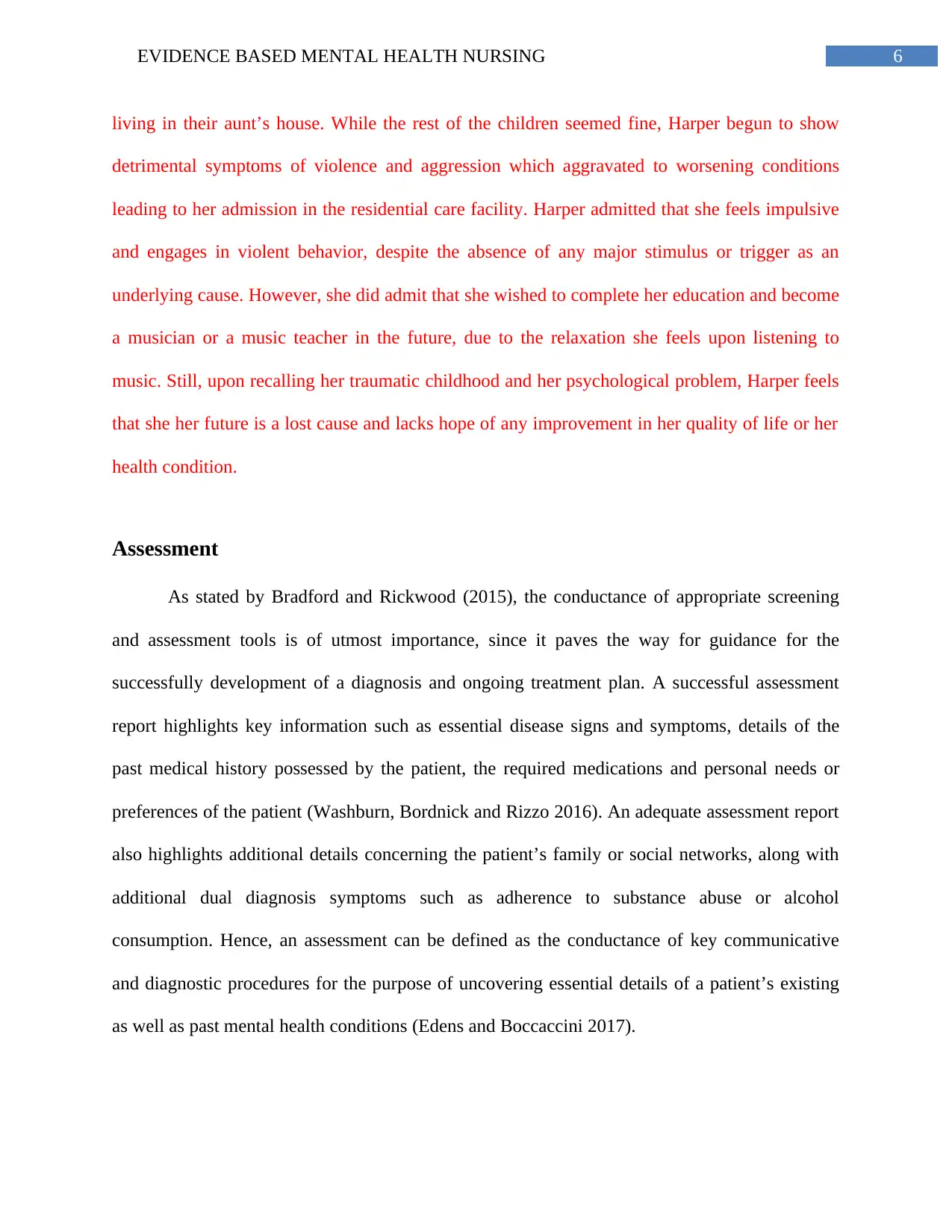
6EVIDENCE BASED MENTAL HEALTH NURSING
living in their aunt’s house. While the rest of the children seemed fine, Harper begun to show
detrimental symptoms of violence and aggression which aggravated to worsening conditions
leading to her admission in the residential care facility. Harper admitted that she feels impulsive
and engages in violent behavior, despite the absence of any major stimulus or trigger as an
underlying cause. However, she did admit that she wished to complete her education and become
a musician or a music teacher in the future, due to the relaxation she feels upon listening to
music. Still, upon recalling her traumatic childhood and her psychological problem, Harper feels
that she her future is a lost cause and lacks hope of any improvement in her quality of life or her
health condition.
Assessment
As stated by Bradford and Rickwood (2015), the conductance of appropriate screening
and assessment tools is of utmost importance, since it paves the way for guidance for the
successfully development of a diagnosis and ongoing treatment plan. A successful assessment
report highlights key information such as essential disease signs and symptoms, details of the
past medical history possessed by the patient, the required medications and personal needs or
preferences of the patient (Washburn, Bordnick and Rizzo 2016). An adequate assessment report
also highlights additional details concerning the patient’s family or social networks, along with
additional dual diagnosis symptoms such as adherence to substance abuse or alcohol
consumption. Hence, an assessment can be defined as the conductance of key communicative
and diagnostic procedures for the purpose of uncovering essential details of a patient’s existing
as well as past mental health conditions (Edens and Boccaccini 2017).
living in their aunt’s house. While the rest of the children seemed fine, Harper begun to show
detrimental symptoms of violence and aggression which aggravated to worsening conditions
leading to her admission in the residential care facility. Harper admitted that she feels impulsive
and engages in violent behavior, despite the absence of any major stimulus or trigger as an
underlying cause. However, she did admit that she wished to complete her education and become
a musician or a music teacher in the future, due to the relaxation she feels upon listening to
music. Still, upon recalling her traumatic childhood and her psychological problem, Harper feels
that she her future is a lost cause and lacks hope of any improvement in her quality of life or her
health condition.
Assessment
As stated by Bradford and Rickwood (2015), the conductance of appropriate screening
and assessment tools is of utmost importance, since it paves the way for guidance for the
successfully development of a diagnosis and ongoing treatment plan. A successful assessment
report highlights key information such as essential disease signs and symptoms, details of the
past medical history possessed by the patient, the required medications and personal needs or
preferences of the patient (Washburn, Bordnick and Rizzo 2016). An adequate assessment report
also highlights additional details concerning the patient’s family or social networks, along with
additional dual diagnosis symptoms such as adherence to substance abuse or alcohol
consumption. Hence, an assessment can be defined as the conductance of key communicative
and diagnostic procedures for the purpose of uncovering essential details of a patient’s existing
as well as past mental health conditions (Edens and Boccaccini 2017).
Paraphrase This Document
Need a fresh take? Get an instant paraphrase of this document with our AI Paraphraser
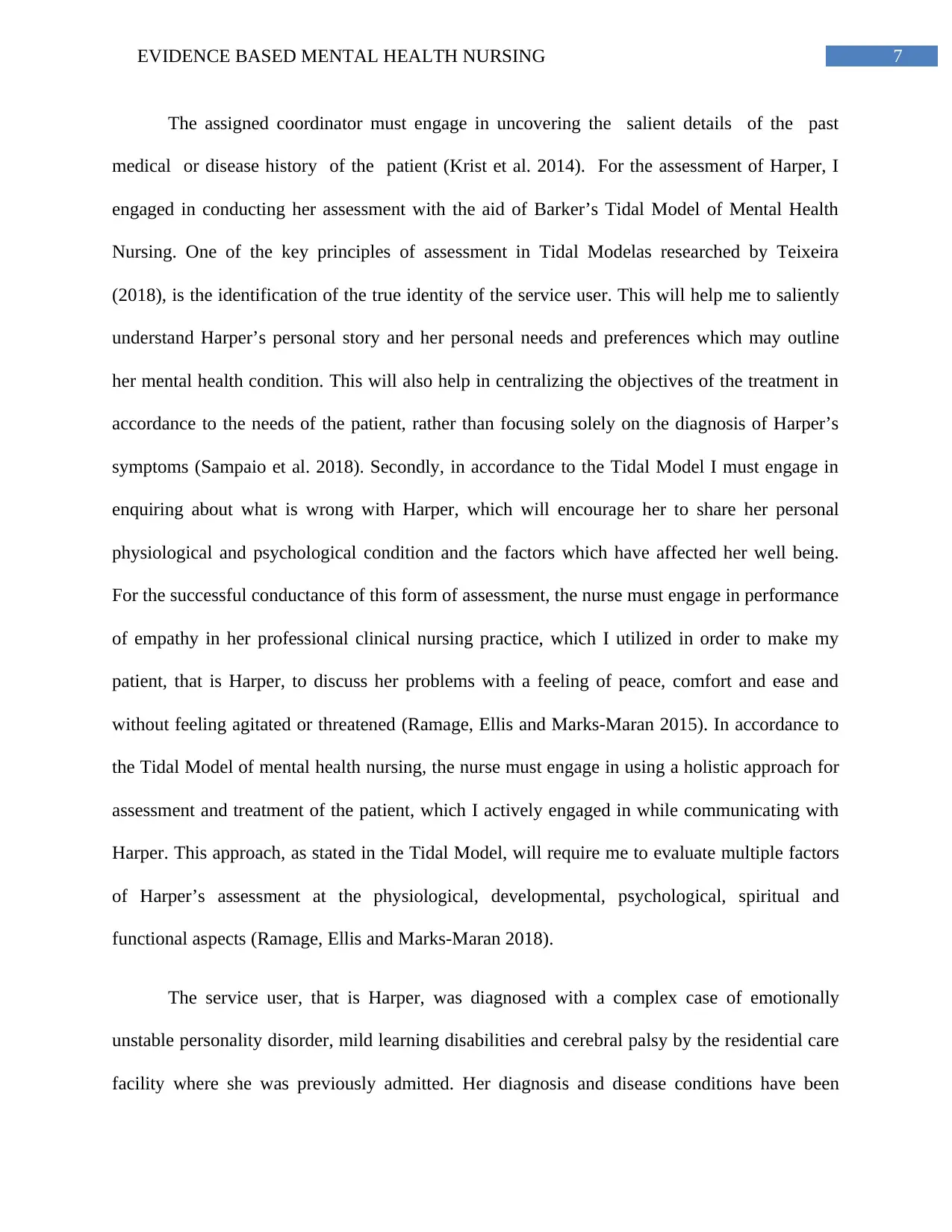
7EVIDENCE BASED MENTAL HEALTH NURSING
The assigned coordinator must engage in uncovering the salient details of the past
medical or disease history of the patient (Krist et al. 2014). For the assessment of Harper, I
engaged in conducting her assessment with the aid of Barker’s Tidal Model of Mental Health
Nursing. One of the key principles of assessment in Tidal Modelas researched by Teixeira
(2018), is the identification of the true identity of the service user. This will help me to saliently
understand Harper’s personal story and her personal needs and preferences which may outline
her mental health condition. This will also help in centralizing the objectives of the treatment in
accordance to the needs of the patient, rather than focusing solely on the diagnosis of Harper’s
symptoms (Sampaio et al. 2018). Secondly, in accordance to the Tidal Model I must engage in
enquiring about what is wrong with Harper, which will encourage her to share her personal
physiological and psychological condition and the factors which have affected her well being.
For the successful conductance of this form of assessment, the nurse must engage in performance
of empathy in her professional clinical nursing practice, which I utilized in order to make my
patient, that is Harper, to discuss her problems with a feeling of peace, comfort and ease and
without feeling agitated or threatened (Ramage, Ellis and Marks-Maran 2015). In accordance to
the Tidal Model of mental health nursing, the nurse must engage in using a holistic approach for
assessment and treatment of the patient, which I actively engaged in while communicating with
Harper. This approach, as stated in the Tidal Model, will require me to evaluate multiple factors
of Harper’s assessment at the physiological, developmental, psychological, spiritual and
functional aspects (Ramage, Ellis and Marks-Maran 2018).
The service user, that is Harper, was diagnosed with a complex case of emotionally
unstable personality disorder, mild learning disabilities and cerebral palsy by the residential care
facility where she was previously admitted. Her diagnosis and disease conditions have been
The assigned coordinator must engage in uncovering the salient details of the past
medical or disease history of the patient (Krist et al. 2014). For the assessment of Harper, I
engaged in conducting her assessment with the aid of Barker’s Tidal Model of Mental Health
Nursing. One of the key principles of assessment in Tidal Modelas researched by Teixeira
(2018), is the identification of the true identity of the service user. This will help me to saliently
understand Harper’s personal story and her personal needs and preferences which may outline
her mental health condition. This will also help in centralizing the objectives of the treatment in
accordance to the needs of the patient, rather than focusing solely on the diagnosis of Harper’s
symptoms (Sampaio et al. 2018). Secondly, in accordance to the Tidal Model I must engage in
enquiring about what is wrong with Harper, which will encourage her to share her personal
physiological and psychological condition and the factors which have affected her well being.
For the successful conductance of this form of assessment, the nurse must engage in performance
of empathy in her professional clinical nursing practice, which I utilized in order to make my
patient, that is Harper, to discuss her problems with a feeling of peace, comfort and ease and
without feeling agitated or threatened (Ramage, Ellis and Marks-Maran 2015). In accordance to
the Tidal Model of mental health nursing, the nurse must engage in using a holistic approach for
assessment and treatment of the patient, which I actively engaged in while communicating with
Harper. This approach, as stated in the Tidal Model, will require me to evaluate multiple factors
of Harper’s assessment at the physiological, developmental, psychological, spiritual and
functional aspects (Ramage, Ellis and Marks-Maran 2018).
The service user, that is Harper, was diagnosed with a complex case of emotionally
unstable personality disorder, mild learning disabilities and cerebral palsy by the residential care
facility where she was previously admitted. Her diagnosis and disease conditions have been
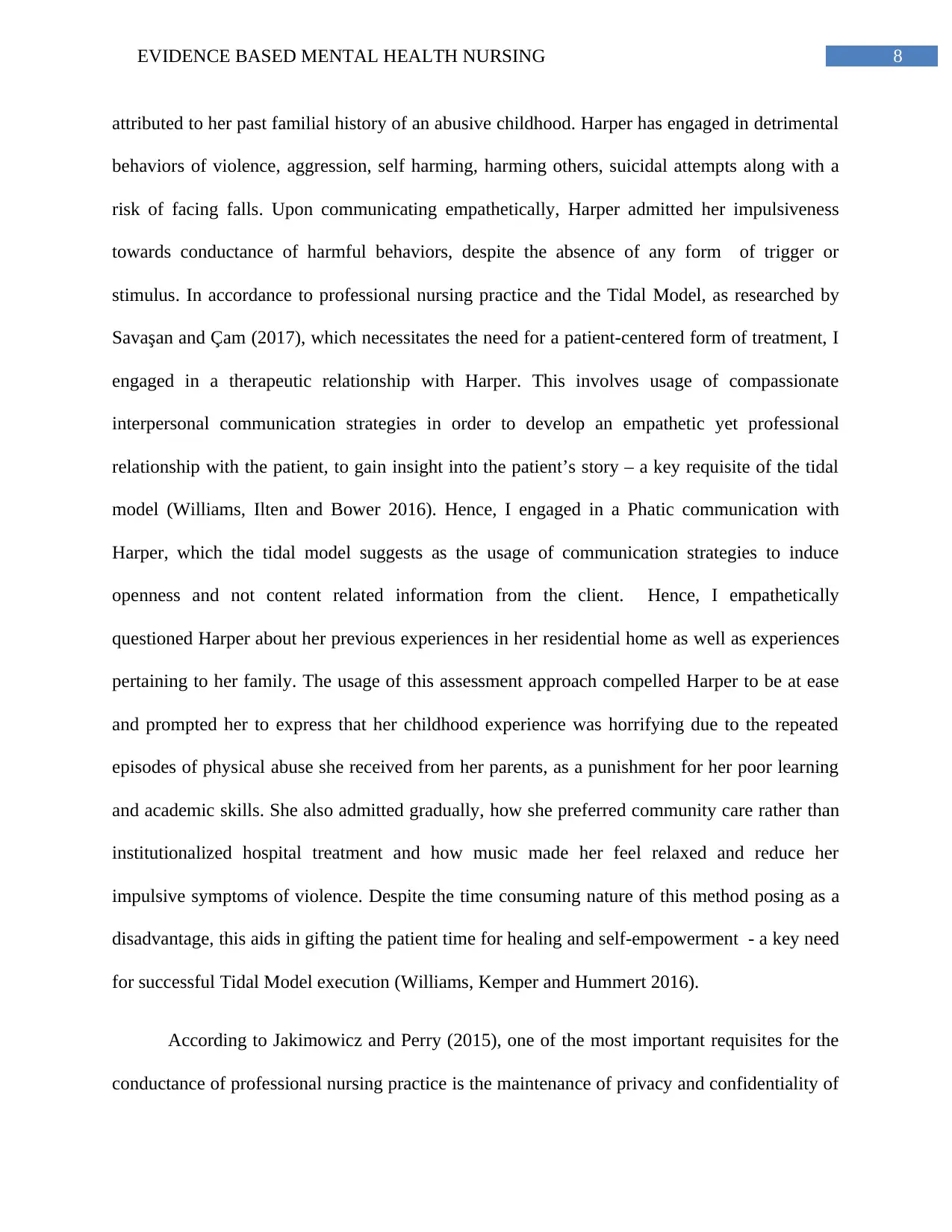
8EVIDENCE BASED MENTAL HEALTH NURSING
attributed to her past familial history of an abusive childhood. Harper has engaged in detrimental
behaviors of violence, aggression, self harming, harming others, suicidal attempts along with a
risk of facing falls. Upon communicating empathetically, Harper admitted her impulsiveness
towards conductance of harmful behaviors, despite the absence of any form of trigger or
stimulus. In accordance to professional nursing practice and the Tidal Model, as researched by
Savaşan and Çam (2017), which necessitates the need for a patient-centered form of treatment, I
engaged in a therapeutic relationship with Harper. This involves usage of compassionate
interpersonal communication strategies in order to develop an empathetic yet professional
relationship with the patient, to gain insight into the patient’s story – a key requisite of the tidal
model (Williams, Ilten and Bower 2016). Hence, I engaged in a Phatic communication with
Harper, which the tidal model suggests as the usage of communication strategies to induce
openness and not content related information from the client. Hence, I empathetically
questioned Harper about her previous experiences in her residential home as well as experiences
pertaining to her family. The usage of this assessment approach compelled Harper to be at ease
and prompted her to express that her childhood experience was horrifying due to the repeated
episodes of physical abuse she received from her parents, as a punishment for her poor learning
and academic skills. She also admitted gradually, how she preferred community care rather than
institutionalized hospital treatment and how music made her feel relaxed and reduce her
impulsive symptoms of violence. Despite the time consuming nature of this method posing as a
disadvantage, this aids in gifting the patient time for healing and self-empowerment - a key need
for successful Tidal Model execution (Williams, Kemper and Hummert 2016).
According to Jakimowicz and Perry (2015), one of the most important requisites for the
conductance of professional nursing practice is the maintenance of privacy and confidentiality of
attributed to her past familial history of an abusive childhood. Harper has engaged in detrimental
behaviors of violence, aggression, self harming, harming others, suicidal attempts along with a
risk of facing falls. Upon communicating empathetically, Harper admitted her impulsiveness
towards conductance of harmful behaviors, despite the absence of any form of trigger or
stimulus. In accordance to professional nursing practice and the Tidal Model, as researched by
Savaşan and Çam (2017), which necessitates the need for a patient-centered form of treatment, I
engaged in a therapeutic relationship with Harper. This involves usage of compassionate
interpersonal communication strategies in order to develop an empathetic yet professional
relationship with the patient, to gain insight into the patient’s story – a key requisite of the tidal
model (Williams, Ilten and Bower 2016). Hence, I engaged in a Phatic communication with
Harper, which the tidal model suggests as the usage of communication strategies to induce
openness and not content related information from the client. Hence, I empathetically
questioned Harper about her previous experiences in her residential home as well as experiences
pertaining to her family. The usage of this assessment approach compelled Harper to be at ease
and prompted her to express that her childhood experience was horrifying due to the repeated
episodes of physical abuse she received from her parents, as a punishment for her poor learning
and academic skills. She also admitted gradually, how she preferred community care rather than
institutionalized hospital treatment and how music made her feel relaxed and reduce her
impulsive symptoms of violence. Despite the time consuming nature of this method posing as a
disadvantage, this aids in gifting the patient time for healing and self-empowerment - a key need
for successful Tidal Model execution (Williams, Kemper and Hummert 2016).
According to Jakimowicz and Perry (2015), one of the most important requisites for the
conductance of professional nursing practice is the maintenance of privacy and confidentiality of
⊘ This is a preview!⊘
Do you want full access?
Subscribe today to unlock all pages.

Trusted by 1+ million students worldwide
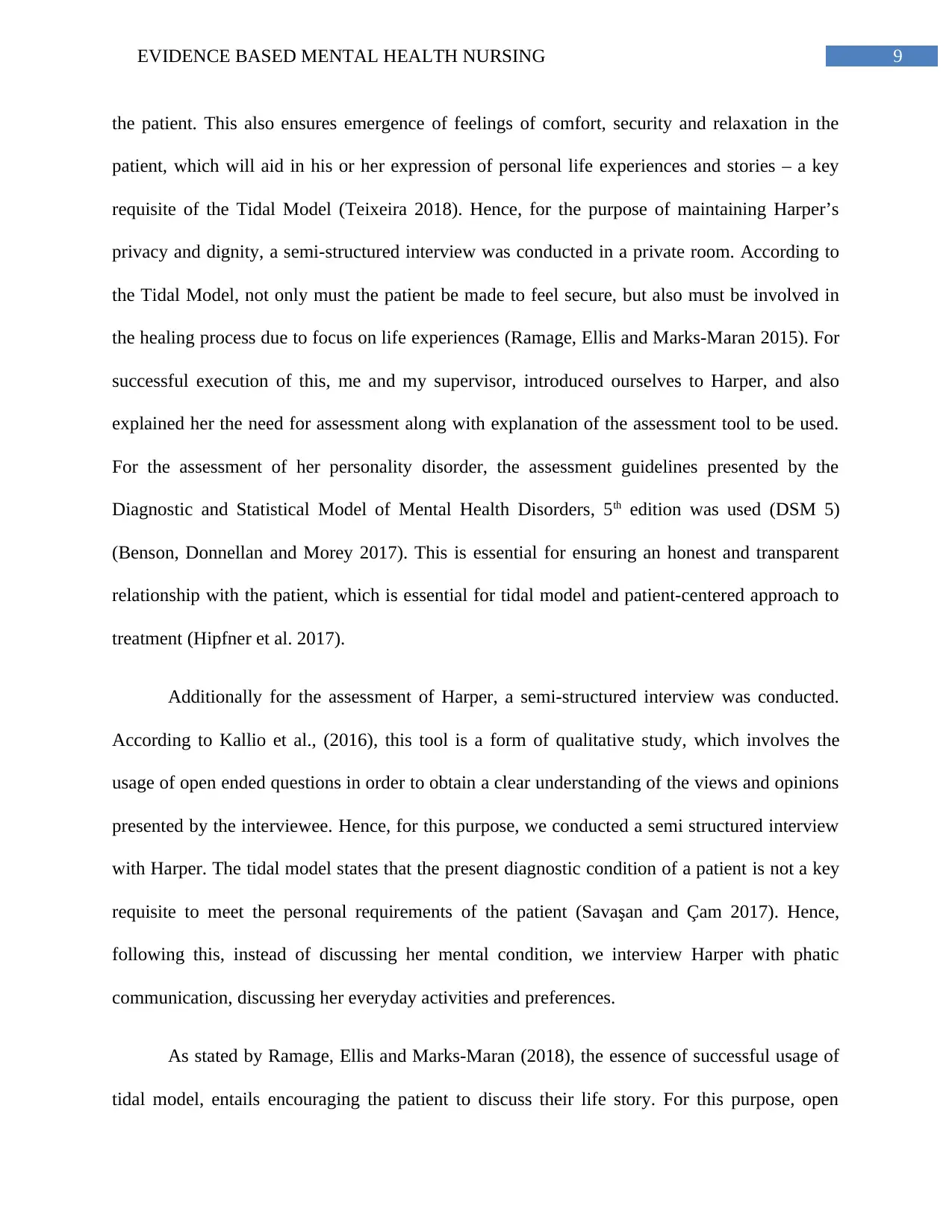
9EVIDENCE BASED MENTAL HEALTH NURSING
the patient. This also ensures emergence of feelings of comfort, security and relaxation in the
patient, which will aid in his or her expression of personal life experiences and stories – a key
requisite of the Tidal Model (Teixeira 2018). Hence, for the purpose of maintaining Harper’s
privacy and dignity, a semi-structured interview was conducted in a private room. According to
the Tidal Model, not only must the patient be made to feel secure, but also must be involved in
the healing process due to focus on life experiences (Ramage, Ellis and Marks-Maran 2015). For
successful execution of this, me and my supervisor, introduced ourselves to Harper, and also
explained her the need for assessment along with explanation of the assessment tool to be used.
For the assessment of her personality disorder, the assessment guidelines presented by the
Diagnostic and Statistical Model of Mental Health Disorders, 5th edition was used (DSM 5)
(Benson, Donnellan and Morey 2017). This is essential for ensuring an honest and transparent
relationship with the patient, which is essential for tidal model and patient-centered approach to
treatment (Hipfner et al. 2017).
Additionally for the assessment of Harper, a semi-structured interview was conducted.
According to Kallio et al., (2016), this tool is a form of qualitative study, which involves the
usage of open ended questions in order to obtain a clear understanding of the views and opinions
presented by the interviewee. Hence, for this purpose, we conducted a semi structured interview
with Harper. The tidal model states that the present diagnostic condition of a patient is not a key
requisite to meet the personal requirements of the patient (Savaşan and Çam 2017). Hence,
following this, instead of discussing her mental condition, we interview Harper with phatic
communication, discussing her everyday activities and preferences.
As stated by Ramage, Ellis and Marks-Maran (2018), the essence of successful usage of
tidal model, entails encouraging the patient to discuss their life story. For this purpose, open
the patient. This also ensures emergence of feelings of comfort, security and relaxation in the
patient, which will aid in his or her expression of personal life experiences and stories – a key
requisite of the Tidal Model (Teixeira 2018). Hence, for the purpose of maintaining Harper’s
privacy and dignity, a semi-structured interview was conducted in a private room. According to
the Tidal Model, not only must the patient be made to feel secure, but also must be involved in
the healing process due to focus on life experiences (Ramage, Ellis and Marks-Maran 2015). For
successful execution of this, me and my supervisor, introduced ourselves to Harper, and also
explained her the need for assessment along with explanation of the assessment tool to be used.
For the assessment of her personality disorder, the assessment guidelines presented by the
Diagnostic and Statistical Model of Mental Health Disorders, 5th edition was used (DSM 5)
(Benson, Donnellan and Morey 2017). This is essential for ensuring an honest and transparent
relationship with the patient, which is essential for tidal model and patient-centered approach to
treatment (Hipfner et al. 2017).
Additionally for the assessment of Harper, a semi-structured interview was conducted.
According to Kallio et al., (2016), this tool is a form of qualitative study, which involves the
usage of open ended questions in order to obtain a clear understanding of the views and opinions
presented by the interviewee. Hence, for this purpose, we conducted a semi structured interview
with Harper. The tidal model states that the present diagnostic condition of a patient is not a key
requisite to meet the personal requirements of the patient (Savaşan and Çam 2017). Hence,
following this, instead of discussing her mental condition, we interview Harper with phatic
communication, discussing her everyday activities and preferences.
As stated by Ramage, Ellis and Marks-Maran (2018), the essence of successful usage of
tidal model, entails encouraging the patient to discuss their life story. For this purpose, open
Paraphrase This Document
Need a fresh take? Get an instant paraphrase of this document with our AI Paraphraser
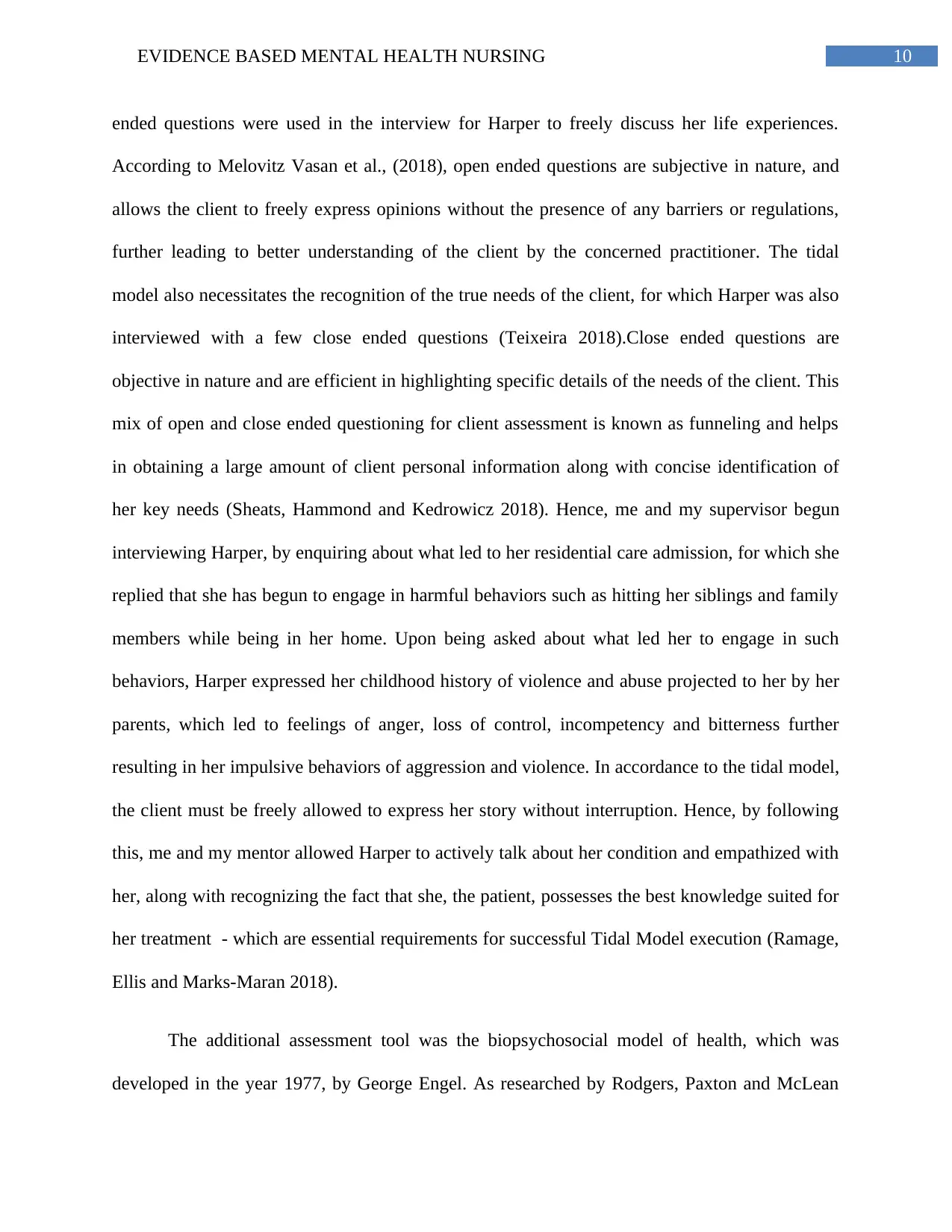
10EVIDENCE BASED MENTAL HEALTH NURSING
ended questions were used in the interview for Harper to freely discuss her life experiences.
According to Melovitz Vasan et al., (2018), open ended questions are subjective in nature, and
allows the client to freely express opinions without the presence of any barriers or regulations,
further leading to better understanding of the client by the concerned practitioner. The tidal
model also necessitates the recognition of the true needs of the client, for which Harper was also
interviewed with a few close ended questions (Teixeira 2018).Close ended questions are
objective in nature and are efficient in highlighting specific details of the needs of the client. This
mix of open and close ended questioning for client assessment is known as funneling and helps
in obtaining a large amount of client personal information along with concise identification of
her key needs (Sheats, Hammond and Kedrowicz 2018). Hence, me and my supervisor begun
interviewing Harper, by enquiring about what led to her residential care admission, for which she
replied that she has begun to engage in harmful behaviors such as hitting her siblings and family
members while being in her home. Upon being asked about what led her to engage in such
behaviors, Harper expressed her childhood history of violence and abuse projected to her by her
parents, which led to feelings of anger, loss of control, incompetency and bitterness further
resulting in her impulsive behaviors of aggression and violence. In accordance to the tidal model,
the client must be freely allowed to express her story without interruption. Hence, by following
this, me and my mentor allowed Harper to actively talk about her condition and empathized with
her, along with recognizing the fact that she, the patient, possesses the best knowledge suited for
her treatment - which are essential requirements for successful Tidal Model execution (Ramage,
Ellis and Marks-Maran 2018).
The additional assessment tool was the biopsychosocial model of health, which was
developed in the year 1977, by George Engel. As researched by Rodgers, Paxton and McLean
ended questions were used in the interview for Harper to freely discuss her life experiences.
According to Melovitz Vasan et al., (2018), open ended questions are subjective in nature, and
allows the client to freely express opinions without the presence of any barriers or regulations,
further leading to better understanding of the client by the concerned practitioner. The tidal
model also necessitates the recognition of the true needs of the client, for which Harper was also
interviewed with a few close ended questions (Teixeira 2018).Close ended questions are
objective in nature and are efficient in highlighting specific details of the needs of the client. This
mix of open and close ended questioning for client assessment is known as funneling and helps
in obtaining a large amount of client personal information along with concise identification of
her key needs (Sheats, Hammond and Kedrowicz 2018). Hence, me and my supervisor begun
interviewing Harper, by enquiring about what led to her residential care admission, for which she
replied that she has begun to engage in harmful behaviors such as hitting her siblings and family
members while being in her home. Upon being asked about what led her to engage in such
behaviors, Harper expressed her childhood history of violence and abuse projected to her by her
parents, which led to feelings of anger, loss of control, incompetency and bitterness further
resulting in her impulsive behaviors of aggression and violence. In accordance to the tidal model,
the client must be freely allowed to express her story without interruption. Hence, by following
this, me and my mentor allowed Harper to actively talk about her condition and empathized with
her, along with recognizing the fact that she, the patient, possesses the best knowledge suited for
her treatment - which are essential requirements for successful Tidal Model execution (Ramage,
Ellis and Marks-Maran 2018).
The additional assessment tool was the biopsychosocial model of health, which was
developed in the year 1977, by George Engel. As researched by Rodgers, Paxton and McLean
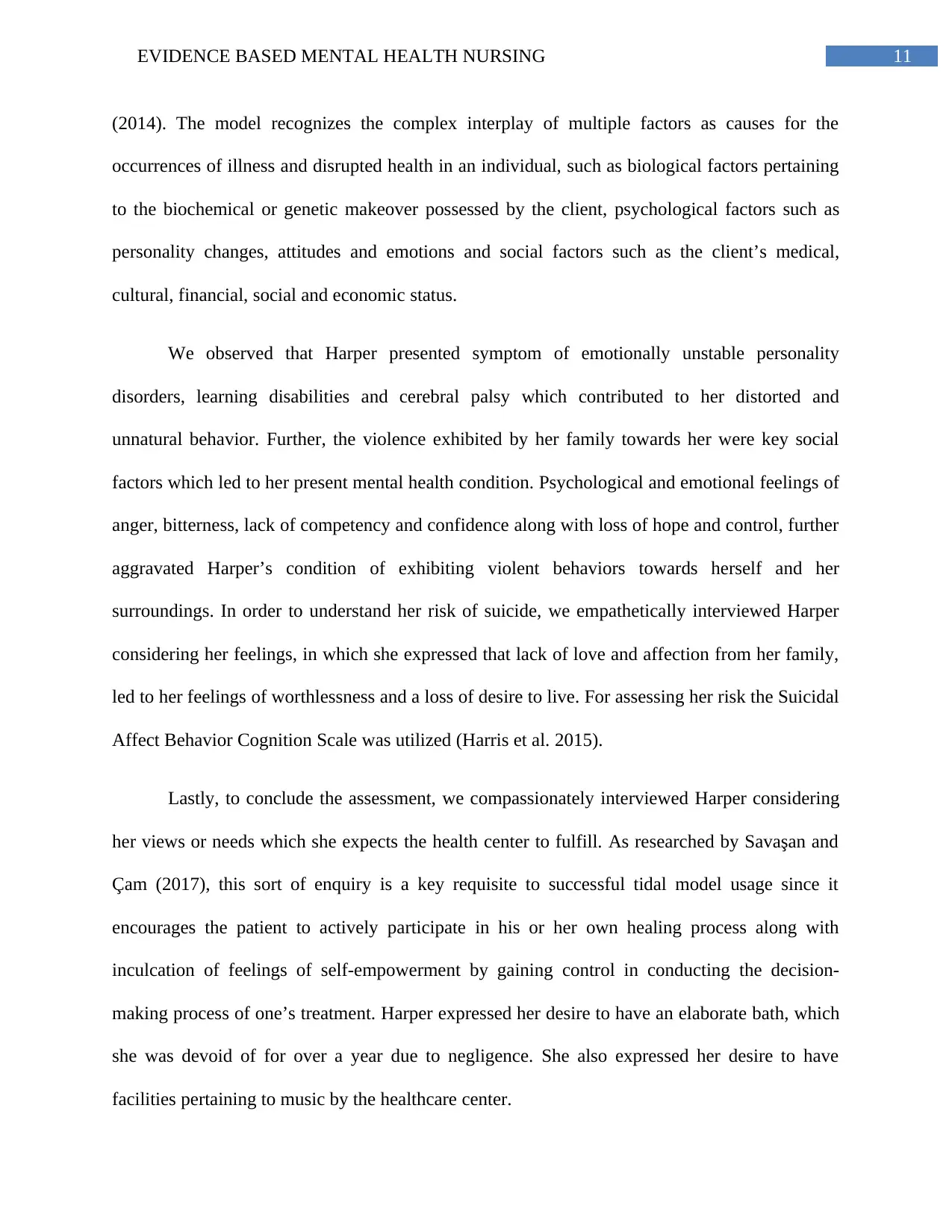
11EVIDENCE BASED MENTAL HEALTH NURSING
(2014). The model recognizes the complex interplay of multiple factors as causes for the
occurrences of illness and disrupted health in an individual, such as biological factors pertaining
to the biochemical or genetic makeover possessed by the client, psychological factors such as
personality changes, attitudes and emotions and social factors such as the client’s medical,
cultural, financial, social and economic status.
We observed that Harper presented symptom of emotionally unstable personality
disorders, learning disabilities and cerebral palsy which contributed to her distorted and
unnatural behavior. Further, the violence exhibited by her family towards her were key social
factors which led to her present mental health condition. Psychological and emotional feelings of
anger, bitterness, lack of competency and confidence along with loss of hope and control, further
aggravated Harper’s condition of exhibiting violent behaviors towards herself and her
surroundings. In order to understand her risk of suicide, we empathetically interviewed Harper
considering her feelings, in which she expressed that lack of love and affection from her family,
led to her feelings of worthlessness and a loss of desire to live. For assessing her risk the Suicidal
Affect Behavior Cognition Scale was utilized (Harris et al. 2015).
Lastly, to conclude the assessment, we compassionately interviewed Harper considering
her views or needs which she expects the health center to fulfill. As researched by Savaşan and
Çam (2017), this sort of enquiry is a key requisite to successful tidal model usage since it
encourages the patient to actively participate in his or her own healing process along with
inculcation of feelings of self-empowerment by gaining control in conducting the decision-
making process of one’s treatment. Harper expressed her desire to have an elaborate bath, which
she was devoid of for over a year due to negligence. She also expressed her desire to have
facilities pertaining to music by the healthcare center.
(2014). The model recognizes the complex interplay of multiple factors as causes for the
occurrences of illness and disrupted health in an individual, such as biological factors pertaining
to the biochemical or genetic makeover possessed by the client, psychological factors such as
personality changes, attitudes and emotions and social factors such as the client’s medical,
cultural, financial, social and economic status.
We observed that Harper presented symptom of emotionally unstable personality
disorders, learning disabilities and cerebral palsy which contributed to her distorted and
unnatural behavior. Further, the violence exhibited by her family towards her were key social
factors which led to her present mental health condition. Psychological and emotional feelings of
anger, bitterness, lack of competency and confidence along with loss of hope and control, further
aggravated Harper’s condition of exhibiting violent behaviors towards herself and her
surroundings. In order to understand her risk of suicide, we empathetically interviewed Harper
considering her feelings, in which she expressed that lack of love and affection from her family,
led to her feelings of worthlessness and a loss of desire to live. For assessing her risk the Suicidal
Affect Behavior Cognition Scale was utilized (Harris et al. 2015).
Lastly, to conclude the assessment, we compassionately interviewed Harper considering
her views or needs which she expects the health center to fulfill. As researched by Savaşan and
Çam (2017), this sort of enquiry is a key requisite to successful tidal model usage since it
encourages the patient to actively participate in his or her own healing process along with
inculcation of feelings of self-empowerment by gaining control in conducting the decision-
making process of one’s treatment. Harper expressed her desire to have an elaborate bath, which
she was devoid of for over a year due to negligence. She also expressed her desire to have
facilities pertaining to music by the healthcare center.
⊘ This is a preview!⊘
Do you want full access?
Subscribe today to unlock all pages.

Trusted by 1+ million students worldwide
1 out of 26
Related Documents
Your All-in-One AI-Powered Toolkit for Academic Success.
+13062052269
info@desklib.com
Available 24*7 on WhatsApp / Email
![[object Object]](/_next/static/media/star-bottom.7253800d.svg)
Unlock your academic potential
Copyright © 2020–2025 A2Z Services. All Rights Reserved. Developed and managed by ZUCOL.




